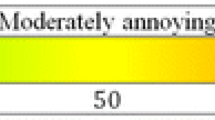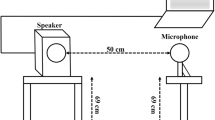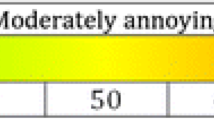Abstract
The aim of this study was to find out whether objective analysis of snoring sounds (sound pressure level and psychoacoustic parameters) correlates with the subjective rating by participants with respect to perceived annoyance and hence whether it is useful. 43 participants, aged 22–65 years with normal hearing, were asked to rate 60 snoring sounds from simple and obstructive snorers according to their level of annoyance. A correlation analysis according to Spearman was then performed on objectively calculated parameters. These were the A-weighted sound pressure level, the psychoacoustic parameters of loudness, sharpness, fluctuation strength and roughness and psychoacoustic annoyance (PA) calculated from those parameters. The subjective ratings showed high, highly significant correlations with, in particular, the mean A-weighted sound pressure level (r = 0.88; p < 0.01), the 5th percentile of psychoacoustic loudness (r = 0.89; p < 0.01) and psychoacoustic annoyance (r = 0.80; p < 0.01). These parameters seem to provide information about the degree of annoyance that is objectively measurable and independent of the snorer’s bed partner. Further studies should follow in order to confirm these results, find out their generalizability and establish reference values.




Similar content being viewed by others
References
Counter P, Wilson JA (2004) The management of simple snoring. Sleep Med Rev 8:433–441. doi:10.1016/j.smrv.2004.03.007
McNicholas WT (2008) Diagnosis of obstructive sleep apnea in adults. Proc Am Thorac Soc 5:154–160. doi:10.1513/pats.200708-118MG
Lee SA, Amis TC, Byth K, Larcos G, Kairaitis K, Robinson TD, Wheatley JR (2008) Heavy snoring as a cause of carotid artery atherosclerosis. Sleep 31:1207–1213
Svensson M, Franklin KA, Theorell-Haglöw J, Lindberg E (2008) Daytime sleepiness relates to snoring independent of the apnea-hypopnea index in women from the general population. Chest 134:919–924. doi:10.1378/chest.08-0847
Virkkula P, Bachour A, Hytönen M, Malmberg H, Salmi T, Maasilta P (2005) Patient- and bed partner-reported symptoms, smoking, and nasal resistance in sleep-disordered breathing. Chest 128:2176–2182. doi:10.1378/chest.128.4.2176
Hoffstein V (1996) Snoring. Chest 109:201–222
Abeyratne UR, Wakwella AS, Hukins C (2005) Pitch jump probability measures for the analysis of snoring sounds in apnea. Physiol Meas 26:779–798. doi:10.1088/0967-3334/26/5/016
Lindberg E, Elmasry A, Janson C, Gislason T (2000) Reported snoring—does validity differ by age? J Sleep Res 9:197–200
Kühnel TS, Schulte-Mattler W, Bigalke H, Wohlfarth K (2008) Treatment of habitual snoring with botulinum toxin: a pilot study. Sleep Breath 12:63–68. doi:10.1007/s11325-007-0136-8
Jones TM, Walker P, Ho M, Earis JE, Swift AC, Charters P (2006) Acoustic parameters of snoring sound to assess the effectiveness of sleep nasendoscopy in predicting surgical outcome. Otolaryngol Head Neck Surg 135:269–275. doi:10.1016/j.otohns.2005.11.051
Jones TM, Ho MS, Earis JE, Swift AC, Charters P (2006) Acoustic parameters of snoring sound to compare natural snores with snores during ‘steady-state’ propofol sedation. Clin Otolaryngol 31:46–52. doi:10.1111/j.1749-4486.2006.01136.x
Herzog M, Schmidt A, Bremert T, Herzog B, Hosemann W, Kaftan H (2008) Analysed snoring sounds correlate to obstructive sleep disordered breathing. Eur Arch Otorhinolaryngol 265:105–113. doi:10.1007/s00405-007-0408-8
Sériès F, Marc I, Atton L (1993) Comparison of snoring measured at home and during polysomnographic studies. Chest 103:1769–1773
Hoeger R, Schreckenberg D, Felscher-Suhr U, Griefahn B (2002) Night-time noise annoyance: state of the art. Noise Health 4:19–25
Fastl H, Zwicker E (2007) Psychoacoustics: facts and models. Springer, Berlin
Caffier PP, Berl JC, Muggli A, Reinhardt A, Jakob A, Möser M, Fietze I, Scherer H, Hölzl M (2007) Snoring noise pollution–the need for objective quantification of annoyance, regulatory guidelines and mandatory therapy for snoring. Physiol Meas 28:25–40. doi:10.1088/0967-3334/28/1/003
Herzog M, Kühnel T, Bremert T, Herzog B, Hosemann W, Kaftan H (2009) The impact of the microphone position on the frequency analysis of snoring sounds. Eur Arch Otorhinolaryngol 266:1315–1322. doi:10.1007/s00405-008-0858-7
Hoffstein V, Mateika S, Anderson D (1994) Snoring: is it in the ear of the beholder? Sleep 17:522–526
Griefahn B, Scheuch K, Jansen G, Spreng M (2004) Protection goals for residents in the vicinity of civil airports. Noise Health 6:51–62
Dreher A, Rader T, Patscheider M, Klemens C, Schmidt M, Baker F, La Chaux R de (2009) The annoyance of snoring. Eur Arch Otorhinolaryngol 266:293–296. doi: 10.1007/s00405-008-0750-5
Pevernagie D, Aarts RM, de Meyer M (2010) The acoustics of snoring. Sleep Med Rev 14:131–144. doi:10.1016/j.smrv.2009.06.002
Ising H, Kruppa B (2004) Health effects caused by noise: evidence in the literature from the past 25 years. Noise Health 6:5–13
Ellermeier W, Mader M, Daniel P (2004) Scaling the unpleasantness of sounds according to the BTL model: ratio-scale representation and psychoacoustical analysis. Acta Acustica United Acustica 90:101–107
Agrawal S, Stone P, McGuinness K, Morris J, Camilleri AE (2002) Sound frequency analysis and the site of snoring in natural and induced sleep. Clin Otolaryngol Allied Sci 27:162–166
Fiz JA, Abad J, Jané R, Riera M, Mañanas MA, Caminal P, Rodenstein D, Morera J (1996) Acoustic analysis of snoring sound in patients with simple snoring and obstructive sleep apnoea. Eur Respir J 9:2365–2370
Wilson K, Stoohs RA, Mulrooney TF, Johnson LJ, Guilleminault C, Huang Z (1999) The snoring spectrum: acoustic assessment of snoring sound intensity in 1,139 individuals undergoing polysomnography. Chest 115:762–770
Herzog M, Bremert T, Herzog B, Hosemann W, Kaftan H, Müller A (2010) Analysis of snoring sound by psychoacoustic parameters. Eur Arch Otorhinolaryngol 1386–1389. doi: 10.1007/s00405-010-1386-9
Conflict of interest
The authors declare that they have no conflict of interest.
Author information
Authors and Affiliations
Corresponding author
Additional information
German Clinical Trials Register (DRKS): trial name: the annoyance of snoring and psychoacoustic parameters, URL: http://www.drks.de/DRKS00003201, registration number: DRKS00003201.
Rights and permissions
About this article
Cite this article
Rohrmeier, C., Herzog, M., Haubner, F. et al. The annoyance of snoring and psychoacoustic parameters: a step towards an objective measurement. Eur Arch Otorhinolaryngol 269, 1537–1543 (2012). https://doi.org/10.1007/s00405-011-1878-2
Received:
Accepted:
Published:
Issue Date:
DOI: https://doi.org/10.1007/s00405-011-1878-2




